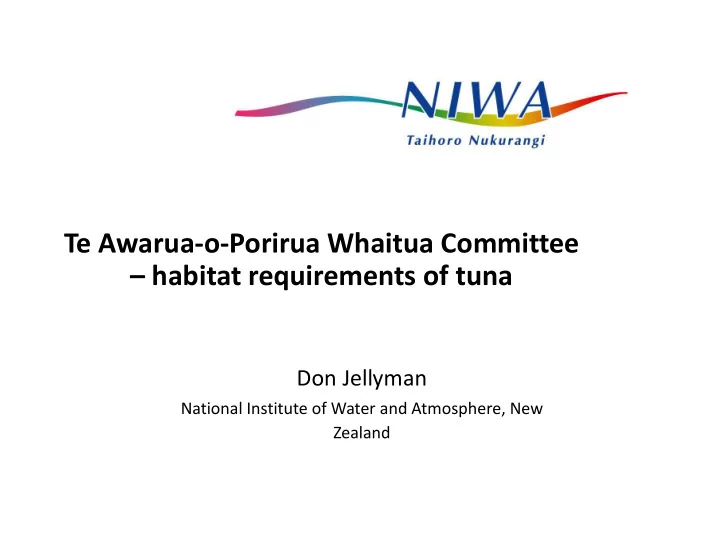

Te Awarua-o-Porirua Whaitua Committee – habitat requirements of tuna Don Jellyman National Institute of Water and Atmosphere, New Zealand
Worldwide distribution of freshwater eels (19 Worldwide distribution of freshwater eels (19 Worldwide distribution of freshwater eels (19 Worldwide distribution of freshwater eels (19 species/subspecies) species/subspecies) species/subspecies) species/subspecies)
New Zealand eels
Longfin eel, Anguilla dieffenbachii , maximum size 2.0 m, 25 kg Shortfin eel, Anguilla australis, maximum size 1.1 m, 3 kg Australian longfin eel, Anguilla reinhardtii , maximum size 2.0 m, 21kg
Longfin eel, Lake Rotoiti, New Zealand. Estimated length 1.7 m, estimated weight 22 kg.
A 1.5 m (14 kg) longfin A 1.5 m (14 kg) longfin A 1.5 m (14 kg) longfin A 1.5 m (14 kg) longfin from a South Island river. from a South Island river. from a South Island river. from a South Island river. - - - - these large females are these large females are these large females are these large females are now protected, but there now protected, but there now protected, but there now protected, but there are markets for them in are markets for them in are markets for them in are markets for them in Asia Asia Asia Asia
Spawning (Sept to Nov) MARINE Egg MARINE Glass eels (Sept to Nov) Photo: U. Kils Leptocephalus Leptocephalus (9-10 months) Adult migrants Life cycle of Tuna Life cycle of Tuna Photo: N. Boustead FRESHWATER FRESHWATER Photo: J. Boubée Elvers (Jan) Adult “feeders” Photo: R. Wells Photo: J. Boubée
Essential habitat components for tuna Flow-related • Minimum flow • Flow variability • Water quality Habitat-related • Instream habitat • Riparian habitat • Instream passage • (Toxins)
Flow Flow- -related habitat components related habitat components Flow Flow - - related habitat components related habitat components • Stream minimum flows and allocation limits; these affect both the quantity and quality of habitat (water temperatures) • Flow variability – some variability is good but very flashy flows from largely impervious urban catchments can be bad for habitat erosion. Floods provide feeding opportunities and stimulate up- and downstream migrations • Water quality; e.g., sediment , metals, nutrient effects on periphyton and dissolved oxygen. Eels relatively resilient but sediment affects types and amount of invertebrate food
Changes in habitat use with size Changes in habitat use with size Changes in habitat use with size Changes in habitat use with size Jellyman et al. 2003. Amer. Fish Soc Symposium 33: 63-78 .
Rainfall (and increased flow) triggers downstream migration of silver eels (heke) Lake Aniwhenua • > 40 mm rainfall triggers migrations • no migration once temperature falls
Part of Abstract from Jellyman et al. 2000
Suggested sequence of events and interactions that lead to demise of Horokiwi (Horokiri) trout stock. The influence of sediment is shown in red
Habitat Habitat- -related components related components Habitat Habitat - - related components related components • Instream habitat not related to flow; e.g., instream cover, undercut banks, debris clusters etc (not uniform concrete beds or edges) • Riparian habitat: e.g. shading to manage temperature and cover from predators, contribute to food • Migration passage; e.g., avoiding restrictive structures like unnegotiable culverts and pipes • Disturbance of historic toxins (DDT) in the soil in parts of the catchment (eels are bio-accumulators of toxins)
19 eels (to 82 cm) came from this debris cluster 31 eels were caught under the collapsed bank on right vs 7 small eels from left bank
The ‘bottleneck” hypothesis Instream cover
Instream passage – avoid perched culverts
Takehome Takehome Takehome Takehome messages messages messages messages • Habitat preferences differ between the 2 species - Longfins prefer flowing water, stony substrates; shortfins prefer slow-flowing reaches, soft sediments • Habitat preferences change with increasing size • Eels are light-avoiding (active at night) so daytime concealment cover is essential • Lack of suitable cover for “adult” eels in Horokiwi was found to be the primary factor limiting their abundance • Excess sediment has major negative impacts
Large flood, October 1941 (from Allen 1951) – the trout population took 4 years to recover from this event
1950 1940’s 1951 1998 1999
Recommend
More recommend